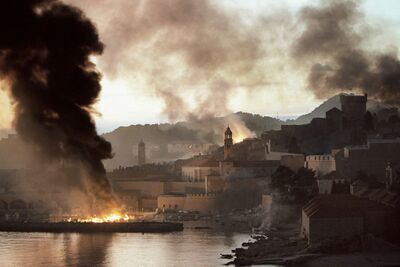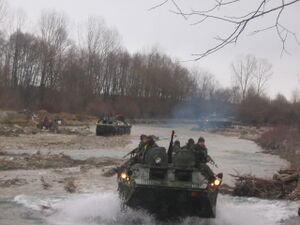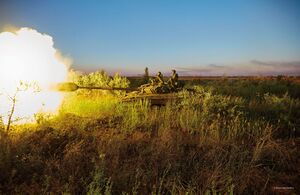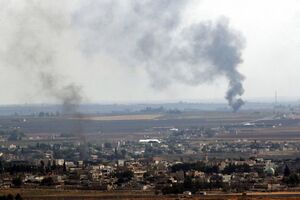Battle of Sagerejo
The Battle of Sagerejo was assault and subsequent occupation of the city of Sagerejo by the Syaran Commonality Armed Forces during the Zemplen War. The bloodiest battle of the entire war, the battle saw extensive urban combat and artillery usage with heavy casualties on both sides. The battle started on 30 April 2009 and concluded on 27 May.
Background
Sagerejo is a strategically important city located in central Ruvelka. Most of Ruvelka's western road network runs through the city, and it offers the most direct route to the vital citides of Polgardi and the capital Debrecen. The city is split in half by the Enguri River, which flows north through the Sagerejo Resevoir until it ends in the Sundering Sea, effectively bisecting north-central Ruvelka. Sagerejo was a major source of logistical support and resupply for the Imperial Army's Army Group Center under the command of General Eliska Hanáková owing to its significant rail and roadway infrastructure.
Field Marhsal Arisdages Koundakjian, commander of Syara's Army Group Beta, was tasked with destroying Ruvelka's Army Group Center as part of the Syaran Spring Offensives and developed Operation Polyandreion in response. Polyandreion called for a massive pincer movement by Army Group Beta's three field armies; 1st Army in the North, 6th Army in the Center, and 9th Army in the South. 1st and 9th Armies would swing south and north respectively to press into the flanks of Army Group Center while 6th Army would then push forward, with all three armies coalescing the Ruvelkans into a massive battle of annihilation where the Ruvelkan Army Group would be destroyed, leaving the road to Debrecen unprotected. This operation, coupled with Syaran efforts in the Kunhegyes and Kenderes Districts, would bring about the collapse of the Imperial Armed Forces of Ruvelka and convince Chancellor Edviná Molnár to sue for peace.
Lying in the path of 1st Army was Sagerejo, which had to either be captured or bypassed in order to complete the northern pincer movement. Having expected the Syaran offensive after the launch of Operation Sagaris in the south, General Hanáková had dug in Ruvelkan forces in-depth across the entire front. When the Syaran offensive began on 20 April the Syarans ran into heavy resistance from the defending Ruvelkans. After ten days of heavy fighting the Syaran corps of 1st Army, X, VI, and XXVIII Corps, had broken through Ruvelkan lines north-west of Sagerejo and began advancing on a frontage over 200 kilometers long.
Planning
General Kukolja, commander of 1st Army, wanted to avoid a pitched urban battle against entrenched Ruvelkan forces and initially hoped to bypass the city. X Corps would move north of the Sagerejo Resevior north of the city and capture Sládkodov 120 kilometers north of the city, while XXVIII Corps would move through Pabiawa through Strálíč. Once crossings across the Enguri River were secure VI Corps could encircle the cities and its defenders while X and XXVIII Corps could proceed to push through the strategic depths of the 11th Kiskőrös and 1st Debrecen Fronts. Kukolja intended for the X and XXVIII Corps to strike simultaneously against the 13th and 1st Armies respectively to prevent the reserve 22nd Army from diverting all of its forces to reinforcing either flank.
Alexander Somogyi, commander of the 11th Kiskőrös Front, had deployed the 32nd Army under Arkina Mkrtchyan directly west of Sagerejo, holding its western most position near Telak. In the north 13th Army under Luca Novák had been forced to postiions north of Droria but had lost Lengyeli to the Syarans on 26 April. In the south 1st Army under Dávid Halász held a thin defensive line from Kežno along the main Dzivyen-Sagerejo Highway, through Liulmita and Călimăsna to Avto in the south.
Having been forced back and losing the cities of Dzivyen and Truperk to the Syarans the previous week, Somogyi wanted to launch a counter attack against the Syaran XXVIII Corps utilizing the 32nd and 1st Armies. He attempted to convince General Krisztina Lakatos, commander of the 1st Debrecen Front, to dispatch the 22nd Army to shore up Ruvelkan positions along Sagerejo to prevent a Syaran counterstroke with VI Corps, but Lakatos was concerned that the still-reeling Ruvelkan forces would be unable to carry out a succesful attack. She instead urged Somogyi to hold off until she could dispatch the 9th Army under Katalin Török to reinforce the Front, which was still disengaging from supporting the fight against the rest of Army Group Beta further south in the Balatonalmádi District.
Course of the battle
Kukolja, a defensive-minded commander by nature, wanted to avoid a contracted battle within the city limits of Sagerejo at all costs, and thus ordered VI Corps to limit its advance at the Sotyn River so the Ruvelkan central forces near the city would not feel pressed to withdraw into Sagerejo. This was also done in the hope that the 32nd Army would be dispatched in an attempt to outflank either X or XXVIII Corps, allowing VI Corps to launch a spoiling attack. The Syarans began their attack in the early morning of 30 April 2009 with airstrikes from the Commonality Air Force and heavy artillery striking Ruvelkan positions along the front.
XXVIII Corps under Lt. General Toni Brajdić moved first with mechanized infantry supported by tanks and heavy mortars of the 10th Mechanized Division striking Ruvelkan positions near Călimăsna, while the 58th Mechanized Division assaulted Ruvelkan positions south of Luilmita. In the north X Corps under Lt. General Dimitar Gorgievski staged out of Krsko assaulsted through north and south of the Krsko canal, which ran straight east towards the vital bridge junctions of Starosiivka and Ełła. Initial Syaran progress was uneven, with Ruvelkan forces of the 21st Infantry and 22nd Grenadier Divisions holding their positions near Luilmita and the 51st Infantry division holding Droria, but the Syaran 10th and 58th Mechanized captured Călimăsna and Avto the next day, threatining the roll through First Army's exposed southern flank. Hopes that the Ruvelkan forces between Lilmita and Zilidijan could counter-attack against the Syaran drive were dashed when VI Corps began pushing east, capturing Telak on the 30th and coming within 15 kilometers of Kežno.
On 2 May Somogyi ordered the Ruvelkans to pull back from their original positions under advice from General Hanáková. 13th Army fell back to Kast and along the Krsko Canal, running north to Lake Hnaefel. 32nd Army fell back beyind the Sotyn River while 1st Army regrouped along the Zilidijan-Krazyn-Pabiawa axis. The act denied the Syarans their desired defeat-in-detail they had hoped to inflict on the flanks and the subsequent Ruvelkan commitment of their reserves. On 3 May the Syarans seized Kežno without firing a shot, but the same day the the Ruvelkans blew every bridge across the Sotyn River. This effectively trapped most of the 32nd Army between the Sotyn River, Sagerejo River, and the city itself to the south, but also meant that VI Corp's only realistic avenue of attack against the city would be directly through the Dzivyen-Sagerejo highway, forcing the Corps into enclosed frontage that would render it highly vulnerable to Ruvelkan artillery and airpower.
General Kukolja decided to pursue the offensive with X Corps continuing its drive north against 13th Army with the goal of capturing Sládkodov, while XXVIII Corps moved south and seized crossing across the Enguri River at Basavăț and Strálíč, positioning both Corps to be able to strike into the rear echelon of the Ruvelkan Front. Unbeknowst to the Syarans, who assumed the 22nd Army was not ready for commitment, the 1st Debrecen Front had steadily been feeding in reinforcments to staging areas east of Sagerejo, creating a growing operation reserve for the Ruvelkans.
Syaran northern attack
X Corps resumed the offensive on 4 May and began the tedious process of clearing out Ruvelkan resistance along the Krsko Canal. Unable to employ their tanks effectively owing to the marshy terrain and with their rifle platoons at a disadvantage against Ruvelkan light infantry in the rough terrain, the Syarans were forced to rely heavily on corps level artillery to break up Ruvelkan pockets and strongpoints. On 8 May the Syaran 20th Mechanized Division reached the outskirts of Starosiivka, the largest crossing over the Enguri River.
Recognizing the danger of a succesful Syaran crossing, General Novák ordered Ruvelkan forces of 13th Army to reinforce their positions along the Enguri. The 275th Infantry Division, which had been bypassed by the Syrans near Kast, counter-attacked against the southern flank of X Corps, reslting in heavy fighting amid the north-east banks of the Sagerejo Resevoir. More 20 Syaran tanks were lost after becoming stuck in the mud and destroyed by Ruvelkan anti-armor weaponry, while across the banks of the Enguri the Syarans attempted to cover their river-crossing with sustained artillery fire. Airstrikes from the Ruvelkan Imperial Air Force twice destroyed bridges costructed by Syaran engineers, and in response Syaran air defense teams downed an AFSF-8 Folivori and an HH1 Helicopter Gunship.
The Syarans succeeded in finally capturing Starosiivka on 13 May, but their push north of the Sagerejo Resevoir forced another pitched battle at Ełła River, which could only be crossed at the eponymously town of Ełła. By now Novák had succeeded in arraying the 13th Army in a strong defense-in-depth, holding not only the Ełła River but also the Sládkodov Canal which ran south to Sagerejo. The steady depletion of the 13th Army was nullified by reinforcemnts from the 22nd Army further south.
Forced to rely on a single paved road connecting Starosiivka to Ełła, X Corps was subject to repeated attacks by Ruvelkan air power, although Syaran anti-air succeeded in down another three aircraft between 13-17 May. On 15 May the Syarans captured Ełła, but repeated strikes by Ruvelkan attack helicopters forced the Syarans to transport much of their troops and armored vehicles over the river using what amphibious capabilities were availible. Although the Ruvelkan 51st Infantry Division by now had to be withdrawn from the fighting due to losses, the rest of 13th Army retired in good order to their defenses along the Sládkodov Canal and near Sládkodov itself.
Syaran efforts continued to run into stiff resistance after crossing the two rivers. On 17 May Gorgievski deployed the 14th Armored Division to break through Ruvelkan defenses along the Sládkodov Canal north of Suziadz. Stiff resistance by the 97th Infantry Division dug-in along the canal, coupled with reserves from 22nd Army including the 112th Grenadier Division, prevented the Syarans from breaking through. Further north the 23rd Mechanized Division attempted to skirt south of Sládkodov itself while the 20th Mechanized Division screened its advance, but the 161st Grenadier Division supported by the 153rd Infantry from the 22nd Army succeeded in halting the Syaran attack. By 20 May Gorgievski called off his Corps push in light of heavy losses, leaving the northern assault dead in the water.
Syaran southern attack
In the south Syaran initial efforts saw more success. Lt. General Senko Penkov Spasov's XXVIII Corps struck Ruvelkan defenses south of Krazyn and within 24 hours had achieved a breakthrough. Halász's First Army counter-attacked with the 289th Hussar Division, but in the relatively open terrain between Pabiawa and Sagerejo Syaran armored forces enjoyed a significant advantage. By 6 May the Syarans had reached the Pabiawa-Sagerejo highway and forced a dilemma on Halász, who had to face potential encirclement in either Zilidijan or Pabiawa. Halász opted to abandon Zilidijan and withdraw further east to Bicfüred, planning to then re-orient Ruvlekan forces in Bicfüred and Pabiawa to strike the Syaran salient along the main highway.
In cojunction with VI Corps the Syarans moved faster, taking advantage of the withdrawal of the 32nd Army closer to the Sagerejo Resevoir, XXVIII Corps struke north and encircled Zilidijan along with the 21st Infantry Division. With First Army now reeling, General Somogyi stepped in and ordered the 1st and 32nd Armies to conduct an immediate counter-attack against Syaran forces between the Sotyn River and Pabiawa. while the 21st Infantry Division would attempt a breakthrough in the direction of Bicfüred. The Ruvelkans began their counterattack on 8 May with First Army's 22nd Grenadier Division, 26th Infantry Division, and what remained of the 289th Hussars. 32nd Army attacked with the 37th and 186th Grenadiers and the 313th Dragoon Division.
Heavy fighting between the 32nd Army and VI Corps broke out across the Dzivyen-Sagerejo Highway involving more than 1,000 armored vehicles and tanks. The sudden attack took the Syarans by surprise, and after a day of intense combat VI Corps was forced to withdraw back west of the Sotyn River. Further south however Ruvelkan fortunes fell short; the 21st Infantry Division's breakout fell short and most of the division was destroyed in the fields between Zildijan and Bicfüred, although around 2,000 Ruvelkan soldiers managed to make it back to friendly lines. The 22nd Grenadier and 26th Infantry Divisions however failed to make significant progress against XXVIII Corps, and on the night of 8-9 May the Syaran 58th Mechanized Division overran the 26th Infantry Division.
First Army's defensive line was now in tatters; What remained of the 26th Infantry, the survivors of the 21st Infantry, and the remnants of the 289th Hussars fell back to Bicfüred, while the 22nd Grenadiers withdrew to Pabiawa. General Halász hoped to reform a new defensive line between Bicfüred, Duban, and Jakb, but the next day the Syarans suddenly struck Pabiawa with the 83rd Motorized Division with the 10th Mechanized began probing Ruvelkan forces north of Bicfüred.
Facing with potential collapse of the entire Army's frontline, Halász opted to abandon Pabiawa and withdraw further east to Livalintin. Halász's decision however faced stron gopposition from Somogyi, who feared that First Army's departure would leave the flank of 32nd Army too exposed. The decision was ultimately forced when VI Corps struck back against Ruvelkan position salong the southern extent of the Sotyn River, bringing the threat of 32nd Army being cut off between the river and Sagerejo Resevoir. General Mkrtchyan, commanding 32nd Army, suggested pulling back her forces towards Sagerejo and establishing a new defensive line between Pucioarie, Aramusa, and Bicfüred. Somogyi opted to abandon Bicfüred intstead and align the defensive line with Bureni and Duban, with First Army holding from Duban to Strálíč.
The Ruvelkans began reforming their line on 10 May, proceeding under heavy fire from Syaran artillery. Recognizing the withdrawal, the Syarans surged forward to capture Jakb and Bicfüred with minimal losses.
Actions by VI and XXVIII Corps
The tactical situation began to turn against the Syarans as they drew closer to the city. Still intent on avoiding a prolonged urban engagement, Colonel General Kukolja re-emphasized the necessity of bypassing the city in a directive issued to his corps commanders on 12 May. In light of the struggles of X Corps, 1st Army re-oriented its focus towards Ruvelkan forces holding their position south of Sagerejo along the Enguri River.





